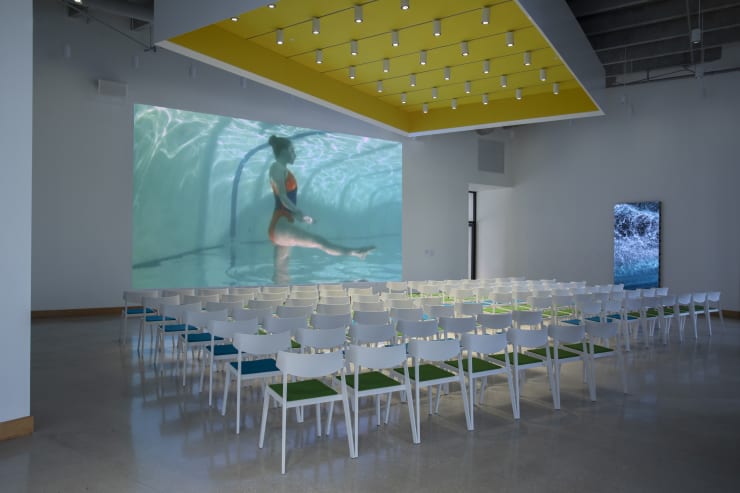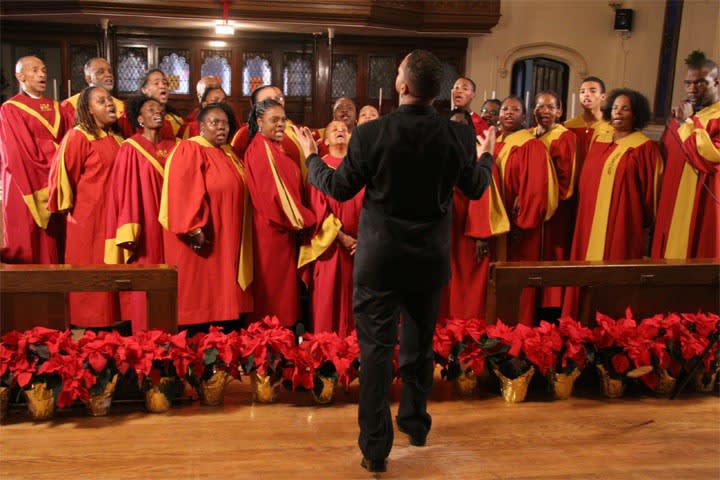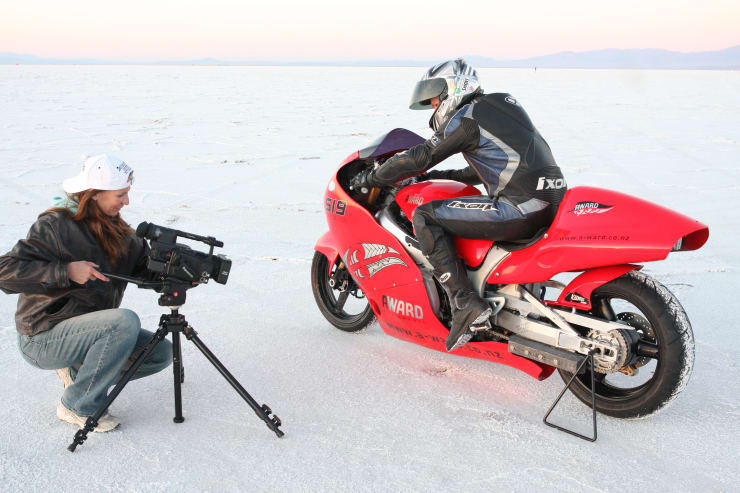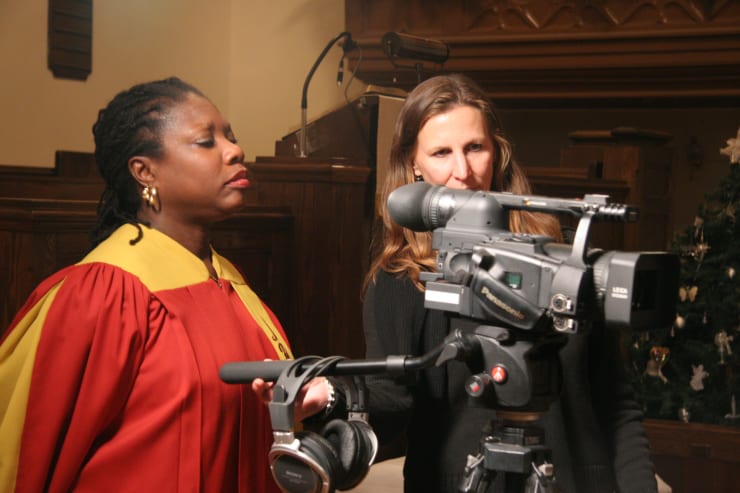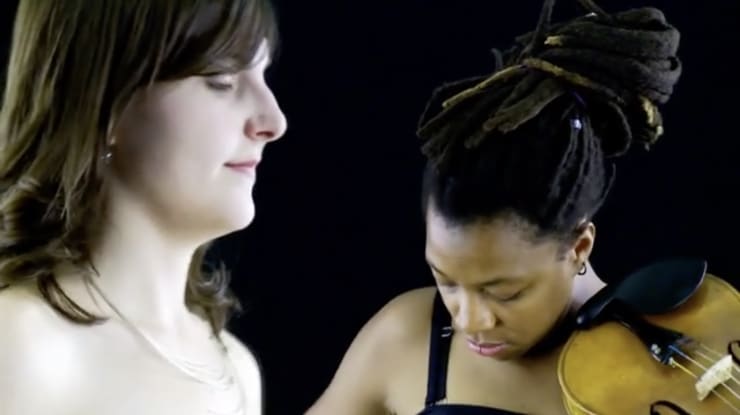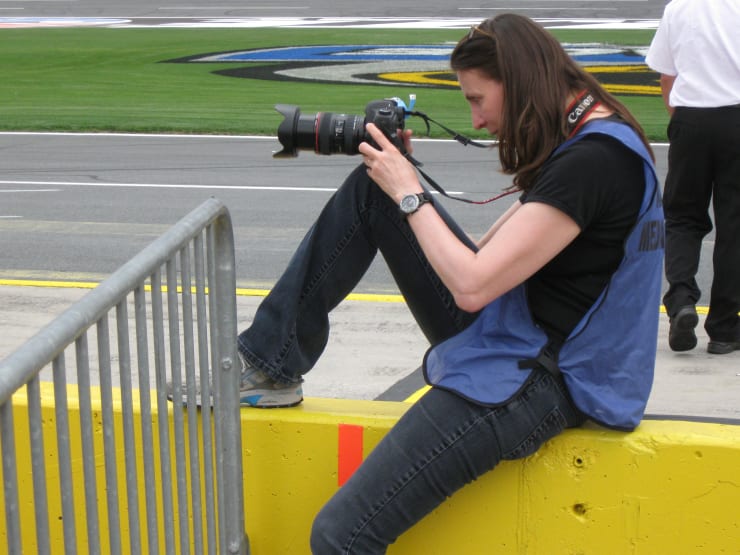-

The final viewing room in (Un)common Denominators takes a closer look at Janet Biggs' videos of people in extreme landscapes and situations. Although the subjects of her works in this section vary greatly, Biggs evaluates all of them through the lens of identity construction. The more pressurized an environment, she argues, the greater the struggle and the need for humans to maintain their sense of self.
Chamblee and Airs Above the Ground follow youthful athletes engaged in sport. As they exert their strength in various feats, their bodies become loci for conversations about the performative aspects of gender. Notions about performance and spectatorship are further explored in the next two videos, which feature individuals in extreme endurance sports. In Duet, NASCAR pit crews race against the clock to get drivers and cars back on the track. Vanishing Point traces speed record-holder Leslie Porterfield's race across the Bonneville salt flats in Utah.
-
Chamblee presents a seemingly endless wrestling bout of teenage sparring partners surging forward and falling back across the screen. They wear identical blue and yellow uniforms, and the setting is a high school gym that could be anywhere. The boys twist and shove into one another, jockeying for the upper hand, muscles tensing with effort.
This is the earliest video by Biggs in the (Un)common Denominators viewing room. Like some of the other works in this section, it is guided by the artist's interest in niche sports that are stylized according to a strict view of gender roles. Wrestling, traditionally viewed as a very masculine sport, is one of the oldest forms of combat as well as entertainment. It's also a rich ground for analysis along feminist, queer and classist lines, among others.
Like in Airs Above the Ground, the subjects in Chamblee are adolescent youth. This age was of particular interest to Biggs in her work from the aughts; to the artist, it represented one of the first moments that we begin to question who we are and how we exist in the world. For these wrestlers, this sport and its broader culture no doubt play a formative role in how they define their identities and social roles.
Sound is frequently an intrinsic part of Biggs' videos, and Chamblee is no different. The action unfolds against a backdrop of layered dialogue culled from male character-driven sports movies. "Can we do it one more time? Let's go! What's the matter with you? Move your asses! We got a game to win. Push it! Push it! What the hell was that? You call that a hit? What are you, female? Keep going! Win! Win! Win! Win! Take your shot. You only get one chance. Hey, it's what we're here for, right?"
-
-
Airs Above the Ground observes a synchronized swimmer as she prepares for and then executes an underwater routine. We watch from beneath the water as she twists and turns, creating an ethereal image of an inverted, weightless swimmer suspended in slow motion. Filtered through the blue, blurry setting of the pool and set to a cello piece composed by William Martina, Airs Above the Ground exudes serenity while also hinting at the effort needed to maintain that appearance.
Biggs was drawn to synchronized swimming for the parallel she saw between the sport and perceptions of youth. She states, "From an adult perspective, there is an idea that there is an effortlessness to youth. But in reality, it's anything but." As the young swimmer moves through the video, it is revealed how much preparation and dedication lies behind her performance. The hyper-stylized gestures and affected costume of the athlete belie the power, agility and strength required to make every action graceful.
When Biggs began to work with adolescents, she was on a quest to find her own authentic voice in her work. Searching for the seeds of her identity, she recalled early memories of feeling powerful and autonomous while riding a horse. Wishing to explore this link further, she turned her focus to youth and gender performativity in adolescence.
The underwater portions of Airs Above the Ground were filmed by Biggs swimming alongside the athlete. The camera was placed in an underwater housing with a cable that ran up to a remote monitor above the water, so that Biggs could get the framing she desired.
-
-
With its title taken from Richard Sarafian's 1971 road movie, Vanishing Point looks at the ways in which an individual vanishes. The video combines images of motorcycle speed record holder Leslie Porterfield with Harlem's Addicts Rehabilitation Center Gospel Choir. As Biggs explains, "I was looking at ways in which individuals disappear, and conversely, ways in which one can become more present, more of themselves, focused solely on the immediate, with no thought of past or future."
Biggs had incredible access to filming Porterfield, who broke three world motorcycle records that year with a top speed of 234 mph. Barreling over the austere and otherworldly landscape, Biggs sat on the back of a truck which drove ahead of Porterfield to capture the footage.
Vanishing Point is Biggs' first work related to Alzheimer's, created shortly after her grandfather was diagnosed with the disease. She found herself contemplating the ways that people can disappear even when they are physically present, and what that means for their identity. For athletes such as Porterfield, the dedication and focus required to become the best can mean they have to disappear from their lives in a sense, prioritizing their sport above all else. Vanishing Point shows what it looks like for Porterfield to be the best, as well as a woman leading in a primarily male-dominated sport.
-
When considering the ways that people can vanish from their lives, Biggs also thought of addiction. A friend introduced her to Harlem's ARC Gospel Choir, founded in 1975 by James Allen with the Addicts Rehabilitation Center. Allen, a former addict, started the a capella choral group to fight against addiction and to offer hope to fellow addicts.
Assisted by Grammy-nominated composer Barney McAll, Biggs wrote a song inspired by the idea of disappearing, the search to regain identity, and the desire to transcend all limits. The ARC Gospel Choir masterfully brings the song to life, emoting its feelings of isolation and self-loss. Sung by a group intended to bring visibility to people who are often invisible, the song's message carries layered meaning in this context.
-
-
Duet was commissioned by The Mint Museum in Charlotte, NC, and screened for the first time at the institution. Charlotte is the home of NASCAR, and Biggs, drawn in by her self-admitted lack of knowledge of the sport, was fascinated by its intensity, skill and extreme duration. High-speed racing's wild popularity and position within consumer culture creates both drama and heroism, but Biggs found herself most interested in the sport's more minor character: the pit crew.
Duet showcases the speed, precision and agility of the pit crews, which the artist termed "ballet-like." The camera sits in the crew's staging area, and we wait and watch alongside the team from this privileged position. To best create the impression that we are part of the action, Biggs prepared by watching the pit crew perform drills in advance of the race.
-
The video is accompanied by a performance of Flower Duet from Léo Delibes' opera Lakmé by singer Martha Joseph and violinist Mazz Swift. Flower Duet is a widely recognized song that frequently appears in advertising and films. Biggs wanted to pair her video footage with something as heavily consumed as NASCAR, and the combination aims to complicate how we see and hear things, particularly things we're used to automatically enjoying.Duet also prominently places two women--one white, one Black--in dialogue with video of a heavily masculine, primarily white subculture. In both arenas, the questions of who assumes the supporting role and who receives the recognition are at play. Alternating between crews of men working on cars and two women in dresses creating a delicate, iconic piece of Classical music, Duet explores issues of gender, race, and the need for extreme grace under pressure when performing prescribed roles.
Extreme Landscapes and Situations
Past viewing_room








